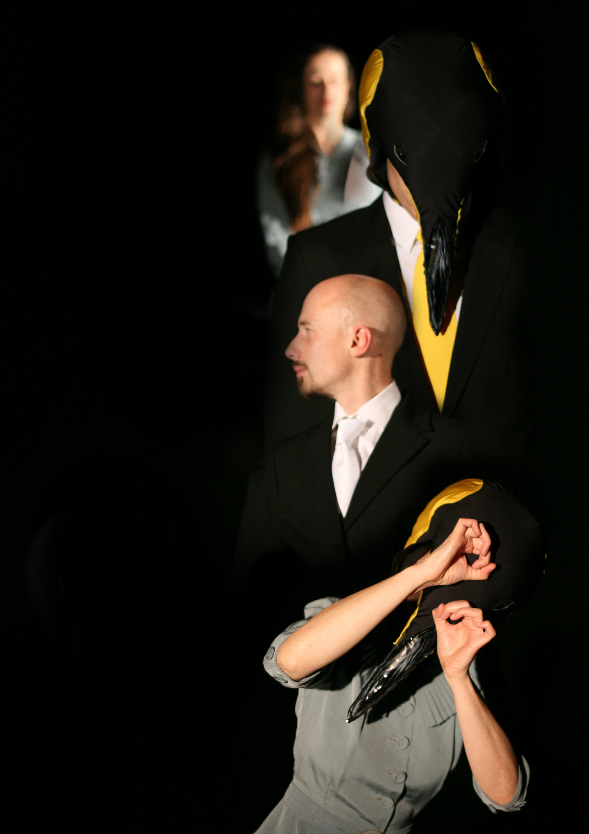As the audience entered the theatre space at Chapter Arts Centre, the four dancers were already on stage and, like the penguins whose movements were a part of the inspiration for the dance-theatre piece Re-creating PenGwyn, moving around the space with purpose. This meant that as audience members we had to find our way into the world being created by the dancers, rather than having it presented to us, prepared as it were behind a curtain. It made for an edgy, engaging start to the performance.
The dancers worked with a mobile set of stacking wooden blocks of different heights, which served as their landscape, through which they sometimes moved stones but, more importantly, their bodies. This landscape, like the polar ice-caps, is bleak, and life there is clearly demanding in ways which words could never convey. Sections of frenetic activity during which two of the dancers would make repeated, staccato moves alternated with that most simple of movements, the individual walking from one point to another. And then standing for a while, one alongside another.

Joanna Young
Theatre Clwyd Cymru
Chapter Arts Centre, Cardiff, 24th October
One of the references for the piece is the work of the sculptor Rachel Whiteread, who has made casts of houses, bookshelves, and other familiar objects which she (literally) casts in a fresh light. We encounter one of her works as something strange and almost surreal, yet it is something we know very well. Looking at it from a different perspective we see it properly for the first time. Joanna Young has created a dance-theatre piece which, in a similar way, makes us look afresh at the everyday – we all walk from place to place, but often carelessly, thoughtlessly. Watching the easy movement of dancers shows us the significance and the poignancy of the everyday, the apparently mundane. There is no laughing at penguins in this show – life for them is serious, as it is for all of us.
There is an eclectic range of music in the show. It ranges from up-beat, engaging tunes from the jazz-rock quartet Get the Blessing, through pulsing electronics from YukoNexus6 to Cagean silence – times when, in the style of John Cage, the sounds of dancers’ movement are themselves the soundtrack to the piece. Hence, when at the climax of the work we see dancer Kirsty Arnold bouncing on the spot for several minutes, stopping, starting again in another spot, and finally being stilled by fellow dancer Caroline Sabin, we are hyper-conscious of the sounds of her feet and of her quickening breathing.
It says much for the power of this work that it held me enthralled for 50 minutes. It was only when I looked at my watch that I realised long it had been. Perhaps a quote in the programme for the show is relevant here: ‘Time we have is not so – vital as time we make.’ (Alistair MacLennan)
I could see at a certain point that the dancers were returning to the material with which they had started the show, but I didn’t want it to end. I felt like the couple who, in 1969, never having heard of the Beatles, watched A Magical Mystery Tour on TV and said afterwards that they had loved it and wished it could have gone on for longer. To me this is about approaching a performance without (too many) preconceptions and allowing its magic to work on you.
I was sitting two seats away from Joanna Young. At the end I turned to congratulate her and found myself choked with emotion. Now, that I had not been expecting when I drove down to Cardiff to see this powerful show.


 Enjoyed this article? Support our writers directly by buying them a coffee and clicking this link.
Enjoyed this article? Support our writers directly by buying them a coffee and clicking this link.








